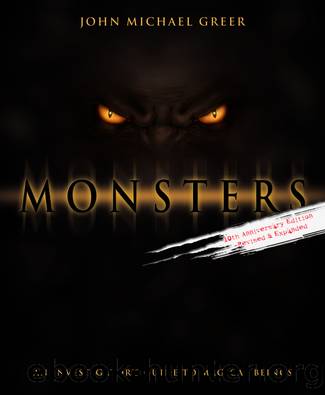Monsters by John Michael Greer

Author:John Michael Greer
Language: eng
Format: epub
Tags: werewolves, vampires, demons, shapeshifters, mythical, myth, creature, demon, beings, evil, monsters, supernatural, beings, magic, ghosts, faery, fairy, UFO, hunters
Publisher: Llewellyn Worldwide, LTD.
Published: 2011-08-05T00:00:00+00:00
[contents]
Dragons
If a competition were to be held for the greatest monster of all time, the dragon would unquestionably win by a large, scaly, fire-breathing head. No other monster is more widespread in folklore, more important in legend and symbolism, or more popular in literature. Equally, however, few other monsters seem to belong so completely to the world of legend and story.
Like chimeras but unlike most of the other monsters examined in this book, the dragon seems to be manufactured out of spare parts from a selection of real animals: batâs wings, lizardâs body, serpentâs tail, and so on. Still, the dragon is a much more complex phenomenon than an ordinary chimera; on the one hand, monstrous beings of a recognizably dragonlike design have been part of lore and human experience over most of the earth, while on the other, there seem to be several different entities mixed together in dragon lore.
To get behind the clouds of confusion surrounding the dragon, itâs necessary to sort out the different elements of the construct, to discard several of the more common assumptions about what dragons are and what they do, and to consider evidence from sources that have rarely been linked to dragons and dragon lore at all.
Partly, the issue is simply a matter of deciding what qualifies as a dragon. The dragon lore of different parts of the world tends to vary dramatically in some details, although other elements remain quite surprisingly stable over space and time. The dragon has a reputation as a shapeshifter, and many stories describe its habit of taking on other forms to trick human beingsâoften to the humansâ undoing.
For the time being, weâll classify as a dragon any entity not currently known to science that combines great size, serpentlike or reptilian form, and a special relationship to magic or supernatural power. Later on, weâll refine this definition somewhat as we close in on the nature of the dragon itself.
What Is a Dragon?
Trying to build up a more precise definition on the basis of any one traditional image of the dragon is not likely to help much. The differences between the types are too great. Our range of choices includes the classical Western dragon, belching flames as it faces the charge of an armor-clad knight; the sinuous Chinese lung chasing a flaming moon-pearl across the heavens; the coiling vision-serpent of the Mayas, with its quetzal-bird feathers and human face; the two-headed ayaâhos of the Puget Sound Salish tribes, coiled around its rock by the sea; and many more. All these are dragons of one sort or another, but common ground between them is not necessarily easy to find.
Letâs examine a few of the most common types in more detail. The standard dragon of Western legend usually has four legs, two batlike wings, a long neck and tail, and a thick coat of protective scalesâalthough there is always one vulnerable patch, usually somewhere on the creatureâs belly. Many accounts and illustrations give it horns, although this doesnât seem to be a consistent part of the legend.
Download
This site does not store any files on its server. We only index and link to content provided by other sites. Please contact the content providers to delete copyright contents if any and email us, we'll remove relevant links or contents immediately.
| Ancient & Controversial Knowledge | Ghosts & Hauntings |
| Hermetism & Rosicrucianism | Magic Studies |
| Occultism | Parapsychology |
| Supernatural | UFOs |
| Unexplained Mysteries |
Animal Frequency by Melissa Alvarez(4400)
Sigil Witchery by Laura Tempest Zakroff(4183)
Real Magic by Dean Radin PhD(4079)
Fingerprints of the Gods by Graham Hancock(3943)
Aleister Crowley: The Biography by Tobias Churton(3590)
Journeys Out of the Body by Robert Monroe(3573)
The Rosicrucians by Christopher McIntosh(3470)
Alchemy and Alchemists by C. J. S. Thompson(3455)
Mysteries by Colin Wilson(3399)
Hitler's Monsters by Eric Kurlander(3270)
The Hatha Yoga Pradipika (Translated) by Svatmarama(3238)
John Dee and the Empire of Angels by Jason Louv(3134)
Wicca: a guide for the solitary practitioner by Scott Cunningham(3128)
Infinite Energy Technologies by Finley Eversole(2940)
Book of Life by Deborah Harkness(2869)
Dark Star Rising by Gary Lachman(2832)
The Book of Lies by Aleister Crowley(2804)
Aliens by Jim Al-Khalili(2789)
To Light a Sacred Flame by Silver RavenWolf(2770)
